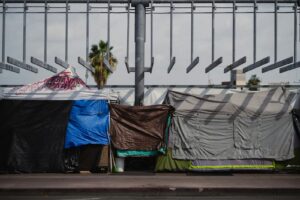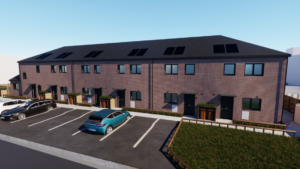Community-led regen is not enough
 We asked six experts to give their verdicts on the events of 2012 and suggest ideas for progression in 2013. In our third instalment, John. P Houghton argues that neighbourhood resilience programmes need to be combined with broader structural change
We asked six experts to give their verdicts on the events of 2012 and suggest ideas for progression in 2013. In our third instalment, John. P Houghton argues that neighbourhood resilience programmes need to be combined with broader structural change
2012 was a year of transition for urban development in the UK. At the start of the year we saw the terminal indications of the passing of the old regeneration model, while the end of the year has witnessed the clearest signs yet of a new approach to reviving the poorest neighbourhoods.
March saw the formal closure of the Housing Market Renewal (HMR) programme. HMR was designed to revive weak housing markets by knocking down old and apparently unwanted houses and replacing them with newer, fewer homes and improved social infrastructure. Its early termination left communities across parts of the north and midlands in limbo, coping with the impact of clearance without a clear plan for what happens next.
Skip forward nine months, and December saw the launch of the final round of Big Local neighbourhoods. Big Local is a new, Lottery-backed programme that supports 150 neighbourhoods across England to build community capacity, support social enterprises and improve their areas.
The programmes couldn’t be more different. They’re at the polar ends of the Robert Moses/Jane Jacobs spectrum along which urban development in the UK regularly, if unpredictably, swings.
Where HMR came with billions of pounds to spend on physical infrastructure, Big Local areas receive a modest £1m over ten years. HMR was plan-led and delivered at sub-regional scale. Big Local is incredibly open-ended, with communities deciding what they want to do with the funding, and focused on ward-sized areas. HMR was overseen by central government and delivered by the big players of the development industry. In one of the few conditions attached to the programme, Big Local must be led by local residents.
The connecting theme between Big Local and other post-regeneration initiatives like the Community Organisers programme, People Powered Change and the Young Foundation’s Building Local Activism project, is the emphasis on building resilience.
Under the old model, the regeneration circus came to town with lots of activities and projects, but didn’t often leave a lasting legacy of community capacity or confidence. In the worst cases, as Julie Fawcett recently blogged for New Start, it actively alienated and disempowered existing residents.
There are many reasons to celebrate this shift from regeneration to resilience, from planned to evolutionary, from professional-led to citizen-led. In the vacuum left by HMR’s demise, we’re already seeing new community-led projects spring up, like 2UP2Down/HomeBaked in Anfield.
So the focus on resilience is absolutely the right starting point. But it’s only one half of the equation that will lead us to sustainable, vibrant neighbourhoods.
The state still needs to support civil society at the local level with co-ordinated action to tackle the big threats of rising inequality and unsustainable development. We can’t expect local projects, which have to spend so much of their energy just surviving from month to month, to tackle these structural problems.
As well as building resilience, we need to gather the forces of the public, private, voluntary and community sectors to drive reconnection. Reconnection is the opposite of polarisation. It’s about integrating poor neighbourhoods and the initiatives within them with the wider economic geography and social fabric, so that the opportunities to learn, get into work and find a new home are open to deprived households.
Without reconnection, resilience becomes nothing more than toughening communities up to battle through an increasingly isolated and marginalised future. Even the most successful local projects will run up against the limits of their power as they struggle against the forces of social division and sprawl which may ultimately defeat them.
Reconnection can be achieved through enlightened economic development frameworks and sustainable planning policies that focus development and investment within existing urban boundaries.
And this can only be done at higher spatial levels and through agencies with wider remits and powers, albeit ones that are nimbler and more accountable to local communities than previous agencies. Local enterprise partnerships may play part of the reconnecting role, but they’re at an early stage of development and have no requirement to tackle inequality or deprivation.
So while we need and must start with Big Local efforts, we also need ‘Big Urban’, ‘Big Sub-Regional’ and ‘Big National’ efforts to trigger and sustain effective neighbourhood renewal in the context of sustainable urban development.
Scotland and Wales may be better placed to achieve this integration, as they have national strategies setting our shared principles and goals. England doesn’t have a strategy, but a sorry collection of homilies and a random list of cut-and-pasted initiatives passed off as the ‘Regeneration Toolkit‘.
2012 was a year of transition. In the neighbourhoods scarred by the failure of regeneration, new projects and initiatives are emerging.
The residents of the poorest neighbourhoods are coming up with their own ideas. But society can’t pat them on the head for their gumption and leave them to fight against the tide. The future has to be about resilience and reconnection.
- Read the rest of our annual round-up: Neil McInroy on the need for a new economic narrative, Phil Baker on the future for public services, Julian Dobson on the emerging sharing economy, Keren Suchecki on welfare and poverty and Richard Caulfield on the challenges ahead for the community and voluntary sector
















Thank you for this article. It makes a great case for the middle way that avoids the done-to top down centralist approaches and also warns against small scale renewal attempted in isolation of connections and wider partnerships. One of the Big Local areas is Kirk Hallam in Derbyshire, announced on 10 December (http://www.ilkestonadvertiser.co.uk/news/ilkeston-news/1m-lottery-boost-for-kirk-hallam-1-5216669). In the first week, this has been one of the central conversations: ensuring local control and local action AND linking, but not being swamped, by the borough and county authorities. The signs are good for an effective and mutually respectful relationship.
A point well made and realised by many neighbourhood managers over the years. Anne Power writes extensively on this interconnection in Jigsaw Cities.
Hi Bill and Sue,
Happy new year, and thanks for your comments.
Bill – yes, I think the task facing Big Local areas is a good example of the challenge of linking the very local with interventions and agencies at higher spatial scales.
Although I question I didn’t have space to explore is how we do that without getting bogged down in complex chains and bureaucratic ‘co-ordination’.
Sue – I think you’ll find that the co-author of Jigsaw Cities is in firm agreement!
Perhaps neighbourhood managers are the answer to my question above – they are often the connecting point between different bodies and groups.
Thanks again for taking time to comment.
John